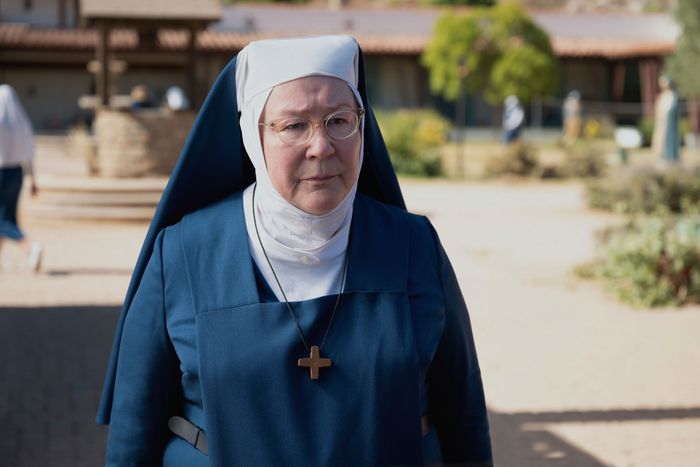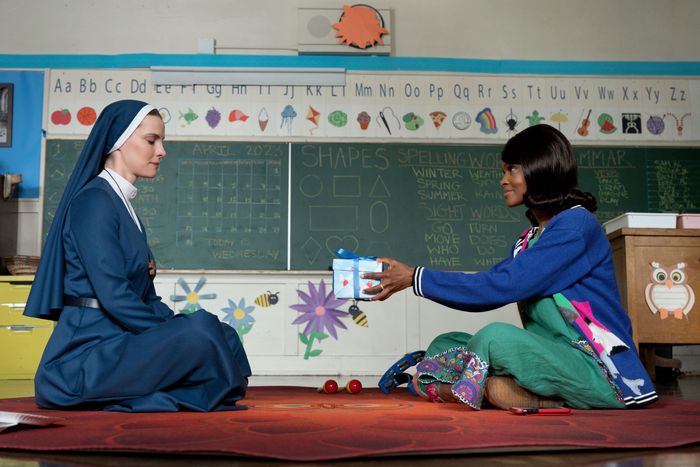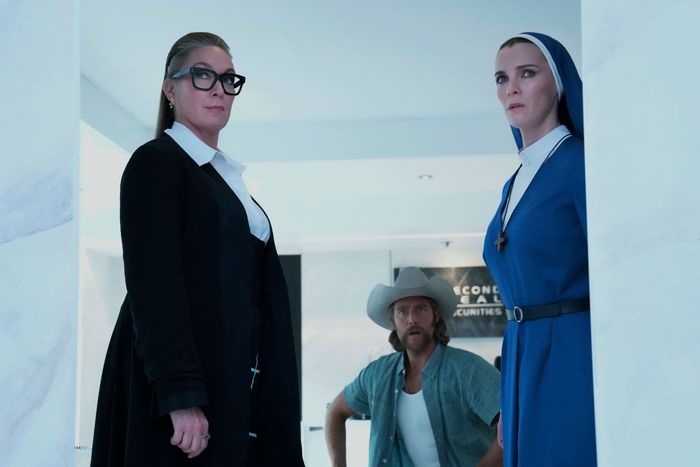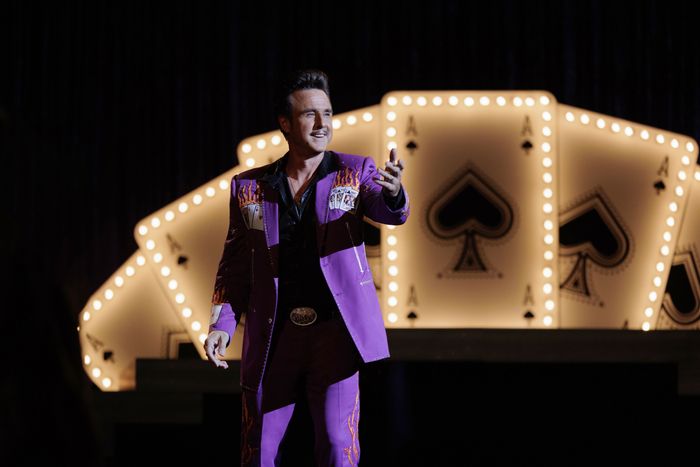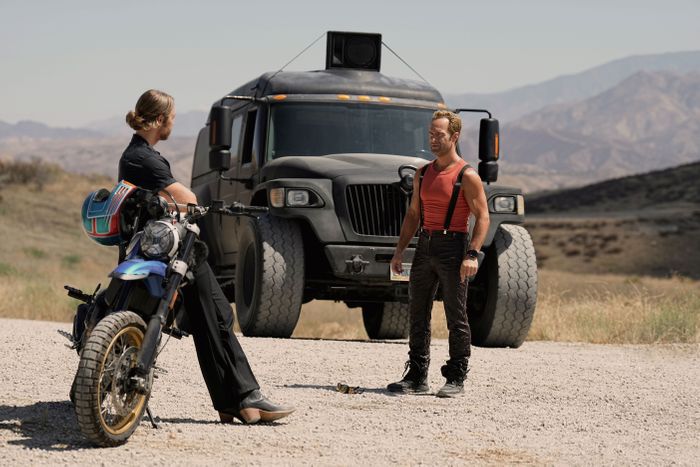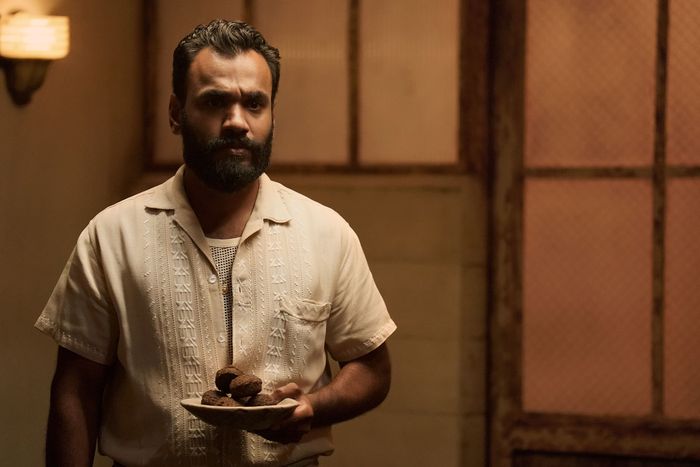
Damon Lindelof first encountered Tara Hernandez while reading through a pile of scripts. Mercy House was “a postapocalyptic, kind-of-comedic pilot about nuns raising children who were about to die,” Lindelof remembers. “I was like, This shouldn’t be funny at all. Who wrote this?”
After adapting Watchmen for HBO, The Leftovers and Lost creator decided that, while he loved working in a writers’ room, he no longer wanted to be in the driver’s seat as showrunner. “I said to Warner Bros. and HBO and the agencies, ‘Send me material by people who have television experience but haven’t run a show and are crazy enough to want to run a show.’” Hernandez’s Mercy House script was darker than what Lindelof was looking for, but the pair were excited about the possibility of creating something ambitious and weird together.
By the time Lindelof and Hernandez started brainstorming in earnest, it was March 2020, and their meetings took place via long, meandering phone calls made while walking through their respective neighborhoods. They retained the idea of centering nuns from Hernandez’s original script but wanted to portray them as radical, joyful figures rather than strict disciplinarians. At the same time, they spent many of their calls discussing early-2020 things: whether to disinfect groceries, when it was important to wear a mask, how to find toilet paper. “We had so many questions that all felt like hearsay and speculation,” Hernandez says. “Tara said, ‘I wish there was an app we could click on that would tell us what to do,’” Lindelof remembers. “Within half an hour, it was, That’s what the nuns should be fighting against. Because if that app existed, it would ultimately replace God.”
What evolved from these conversations is Mrs. Davis, a Peacock series debuting April 20 about a nun named Simone (Betty Gilpin) who, based on her beliefs and a distrust of cheap magic, decides to take down a seemingly benevolent algorithm that has won over the entire world. It is a sci-fi romp about faith and computers and a love story about God and gamification, and it’s somehow also a wacky fetch-quest narrative about death, mid-tier Reno magicians, and the Holy Grail. Much of Mrs. Davis is difficult to discuss without ruining several of its best surprises, but its underlying preoccupations are most apparent in its many divergent influences — and what it clearly is not. “We were pushing back against dystopia,” Lindelof says, but the show needed to be “fun to watch, not a huge downer. Where in the Venn diagram do The Sound of Music, Black Mirror, and True Romance overlap? That’s what we were gunning for.”
The Sound of Music.
“I love characters with passion,” Hernandez says. “I respond to people who commit, and I can’t imagine a deeper commitment than nuns, who literally take vows.” Rather than a devotion to ascetism or a fear of losing one’s faith, Hernandez and Lindelof were interested in depicting a life in a convent that Simone would want to embrace — one driven by trust in God and a warm communal life dedicated to making the world better. For Hernandez, that image was informed by her long-standing love of The Sound of Music, in which Julie Andrews’s Maria leaves the convent but never loses her sense of joy or her moral compass for compassion and justice. Simone represents the “running on the hilltop” Maria, Hernandez says, and an ideology built on a love of nature and humanity.
An elementary-school teacher named Mrs. Davis.
Simone’s adversary would not be a Terminator vision of apocalyptic artificial intelligence or 2001: A Space Odyssey’s unnerving, chilly HAL 9000. “We wanted the opposite of exoskeletons crushing human skulls,” Lindelof says. Their AI would be friendly and engaging. “Mrs. Davis’s superpower,” Hernandez says, “is that she’s not going to turn everyone into sheep. They’re going to willingly surrender themselves to her influence.”
The model became Hernandez’s own (much-beloved) first- and second-grade teacher, a woman named Mrs. Davis. “She was a larger-than-life figure for me,” Hernandez says, “a powerful woman who would also pull you aside and whisper something really nurturing and sweet.” Most memorably, she had a way of gently prodding students toward something like a personal thesis statement. This would be key to the show’s algorithmic Mrs. Davis: Characters would experience her as if she’d been created just for them, accessing Mrs. Davis on an app and hearing her voice through earbuds. This format allows Simone to avoid hearing Mrs. Davis’s voice directly; all of their communications are translated through users of the app because they have a personal connection to the algorithm that Simone refuses to create. This makes Mrs. Davis an even more threatening analog to a Christian God, who is often depicted in the Bible as speaking through other people (“or sometimes,” Lindelof points out, “through burning shrubbery”).
Pokemon Go.
Once Lindelof and Hernandez had a handle on who Mrs. Davis would be, they began to map out all the ways she would infiltrate daily life. They landed on a gamified presence, an app that incentivizes philanthropy like a Good Samaritan version of Pokemon Go. In the show, the AR mobile game becomes the primary engine of Mrs. Davis’s influence on the world, a way for any person to earn “angel wings” by completing the tasks she sets for them: personal missions meant to make the world a better place.
“San Junipero.”
The season-three Black Mirror episode “San Junipero” chronicles the love story between two women who meet in a digitally constructed afterlife. It became a key tonal touch point for Mrs. Davis, Hernandez says, because of the tender romance achieved within the high-concept sci-fi premise. As with “San Junipero,” the goal for Mrs. Davis was to “never let the tech or artifice overtake the humanity and relationships,” she says. Plus, Lindelof notes, “the whole ’80s vibe of the episode — the music, the color, the costume design, all that stuff — just seemed so welcoming.”
That Black Mirror inspiration morphed into direct collaboration when “San Junipero” director Owen Harris signed on for Mrs. Davis’s first episode. Lindelof and Hernandez were especially excited about Harris’s ability to find moments of humor in otherwise intense or dark subject matter. “He started bringing in Monty Python references,” Lindelof says.
True Romance.
Simone and her childhood friend Wiley (Jake McDorman) eventually go on a journey across the globe, but Mrs. Davis begins in Nevada amid the iconography of American westerns: horses, rodeos, visions of the desert that toggle between paradise and apocalypse. To define the visual language of the series, Harris looked to early Tarantino, particularly True Romance. The 1993 film has “a lot of over-the-top violence,” Lindelof says, but between the soundtrack and the heightened visual language, it’s able to accomplish comedy, too. “That was where we started to get really delighted,” he says. “What is the threshold for ridiculousness?” It’s a tone he also set in the writers room of The Leftovers and Watchmen, a need to chase “that crazy idea that sounds so stupid and ridiculous and absurd, and then it just lands,” he says. “You look around and everyone’s waiting for someone to say, ‘I kind of like that idea. Should we try it?’”
Mrs. Davis’s stars carry that energy in their performances. Hernandez points to a moment in the first episode when the script calls for Gilpin to climb into a hatch. It became an opportunity for the actor to demonstrate Simone’s sense of humor through a bizarre twisting motion executed as she tries not to drop a detonator. “That was such an aha moment,” Hernandez remembers. “Simone, via Betty, is always going to find the most off-the-beaten-path way to do something.”
Frodo Baggins.
Mrs. Davis can feel like all sorts of disparate cultural touchstones stitched together, and Lindelof and Hernandez mention many others: Dan Brown novels (mostly to make fun of them), the documentaries God Is the Bigger Elvis (a depiction of life as a radical modern nun) and Hands on a Hard Body (which plays into a later episode of the series), The Wizard of Oz (and its skepticism of the man behind the curtain), the magician Penn Jillette, Survivor, Patriot, and people they’ve known. Elements of the series are designed to be familiar nods to recognizable references, but the viewing experience is unique, not beholden to any IP or adapted source and entirely free to be its own weird, distinctive world. Mrs. Davis juggles it all by starting from a single layer of structural and character-based influence: Simone, Hernandez says, is like Frodo Baggins of The Hobbit and The Lord of the Rings, “a reluctant hero character chosen by circumstance.”
Mrs. Davis is able to weave in so many of these strange, specific, picaresque conceits because it’s built as a “there and back again” story, allowing Simone to encounter many experiences and challenges before finally returning home. Simone begins the series feeling disoriented and frustrated, and Lindelof and Hernandez know that may be the experience for some viewers, too. At times, Lindelof admits, Mrs. Davis “does feel a little bit like those montages where boxers are trying to catch a chicken. It’s ridiculous to watch and also a lot more difficult than it looks.”
“But my favorite thing is losing the audience purposefully and then getting them back,” he continues. The very beginning of Mrs. Davis, for instance, is a sequence designed to be pretentious and exactly what the show is not, which he acknowledges is “probably not the best idea to start a show.” That’s the fun of it, though. “Part of the game in a show like this, and in storytelling in general, is to play into the audience’s expectations,” he says. “You have to lean in extra hard if you’re going to try to subvert them. Hopefully it will be really exciting if people get that far.”



